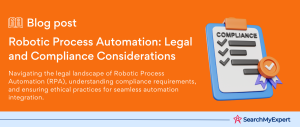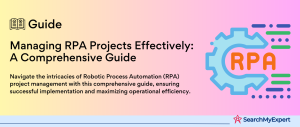Understanding Robotic Process Automation: An Introduction
What is Robotic Process Automation (RPA)?
Robotic Process Automation (RPA), a transformative technology, is revolutionizing the way businesses operate. At its core, RPA refers to the use of software robots, or ‘bots’, that automate repetitive, rule-based tasks traditionally performed by humans. These tasks range from data entry and processing to complex workflow integrations.
Potential Benefits of RPA
- Efficiency and Productivity:
RPA bots work tirelessly, eliminating human errors and significantly speeding up processes. - Cost Reduction: Automating routine tasks reduces labor costs and operational expenses.
- Scalability and Flexibility:
RPA can easily adapt to changing business needs and scale up or down as required. - Improved Accuracy:
With RPA, the risk of human error is minimized, ensuring more accurate data handling. - Employee Empowerment:
By offloading mundane tasks to bots, employees can focus on more strategic, creative work.
Growing Interest and Challenges in RPA Adoption
The allure of RPA is undeniable, with businesses increasingly exploring its potential to enhance efficiency and competitiveness. However, this growing interest is accompanied by challenges:
- Integration Complexity:
Seamlessly integrating RPA with existing systems can be a complex task. - Skill Gap:
There’s a significant skill gap in the workforce to effectively implement and manage RPA solutions. - Managing Expectations:
Balancing the hype around RPA with realistic expectations of its capabilities is crucial. - Security Concerns:
Ensuring the security and compliance of RPA solutions is a major challenge, especially in sensitive industries.
Roadmap of the Upcoming Content
Our journey through the world of RPA will encompass the following key areas:
- Exploring RPA Use Cases in Various Industries:
Understanding how different sectors are leveraging RPA for their unique needs. - RPA Implementation Strategies: Best practices for successful RPA deployment.
- Addressing RPA Challenges:
Navigating through common obstacles and solutions. - Future Trends in RPA: Insights into how RPA is evolving and shaping the future of automation.
Evaluating Organizational Readiness for RPA Implementation
Why Assessing Readiness is Crucial
Before diving into the world of Robotic Process Automation, it’s vital for organizations to assess their readiness. This evaluation serves as a cornerstone for a successful RPA journey, ensuring that the integration of automation aligns with the organization’s capabilities and goals.
Key Factors to Consider in Readiness Assessment
Process Maturity
- Definition and Standardization:
Identify processes that are well-defined and standardized, as these are prime candidates for RPA. - Complexity and Variability:
Assess the complexity and variability of processes. High complexity or variability might require more sophisticated RPA solutions.
Technological Infrastructure
- Current IT Landscape:
Examine the existing IT infrastructure to determine compatibility with RPA tools. - Integration Capabilities: Evaluate the ability of current systems to integrate with RPA software, especially for legacy systems.
Data Governance
- Data Accessibility and Quality:
Ensure data involved in RPA processes is easily accessible and of high quality. - Compliance and Security:
Review data handling practices to ensure they comply with regulatory standards and maintain security.
Conducting a Self-Assessment for RPA Readiness
Internal Review
- Conduct workshops or meetings with key stakeholders to discuss potential RPA opportunities and readiness.
- Use assessment tools or checklists to review current processes, IT infrastructure, and data governance.
Benchmarking
- Compare your organization’s processes and IT setup with industry standards or competitors who have successfully implemented RPA.
Identifying Skill Gaps
- Determine if your organization has the necessary skills for RPA implementation and management. Consider training existing staff or hiring new talent.
Engaging External Consultants for an In-depth Evaluation
- Expert Insight: External consultants bring specialized knowledge and experience in RPA, offering insights that might be overlooked internally.
- Objective Assessment: They provide an unbiased view of your organization’s readiness and potential challenges.
- Strategic Roadmap Development:
Consultants can help in developing a tailored RPA implementation strategy, aligning with your organization’s specific needs and capabilities.
Choosing the Right Processes for RPA Automation
The Importance of Selecting Appropriate Processes
Implementing Robotic Process Automation (RPA) isn’t just about using advanced technology; it’s about identifying the right tasks for automation. The ideal processes for RPA are those that are repetitive and rule-based, as they offer the most significant potential for efficiency gains and cost savings.
Characteristics of Processes Ideal for RPA
- High Repetition and Low Complexity:
Tasks that are performed frequently and have a low level of complexity are prime candidates. - Rule-Based Operations:
Processes that follow a clear set of rules without requiring human judgment. - Stable and Well-Defined: Tasks that have standardized and consistent workflows.
Best Practices for Process Mapping and Analysis
Identify and Document Current Processes:
- Conduct thorough documentation of existing processes to understand each step and its purpose.
- Use flowcharts or process maps to visualize the workflow.
Evaluate Automation Potential:
- Assess the frequency and time taken for each process.
- Analyze the potential return on investment (ROI) from automating each task.
Prioritize Based on Impact and Feasibility:
- Rank processes based on the potential impact of automation and the ease of implementation.
- Focus on processes that can yield quick wins to build momentum and demonstrate the value of RPA.
The Need to Avoid Automating Complex, Judgment-Intensive Tasks
Automating tasks that require complex decision-making or human judgment can lead to challenges. RPA bots are designed to follow predefined rules and lack the capability to handle tasks that require understanding nuances or making subjective decisions.
Practical Tips for Process Selection
- Start Small and Scale:
Begin with simpler, smaller processes to gain confidence and understanding of RPA capabilities. - Involve Relevant Stakeholders: Engage with employees who perform these tasks daily for insights into potential challenges and benefits.
- Continuous Review and Improvement:
Regularly reassess automated processes for improvements and adapt to changes in business operations.
Navigating Change Management in RPA Adoption
Understanding Employee Concerns and Resistance
As organizations embark on their Robotic Process Automation (RPA) journey, acknowledging and addressing employee apprehensions is crucial. Concerns often stem from fears of job displacement, uncertainty about new roles, and a lack of understanding of RPA benefits. Effective change management is key to mitigating these fears and fostering a positive attitude towards RPA.
Communicating the Benefits of RPA
- Transparency and Clarity:
Clearly communicate the purpose, scope, and expected outcomes of RPA implementation. - Highlighting Advantages: Emphasize how RPA can alleviate workload by automating mundane tasks, allowing employees to focus on more engaging and strategic work.
- Demonstrating Value: Share case studies or examples from within or outside the organization where RPA has positively impacted similar roles.
Involving Employees in the Automation Process
- Inclusion in Decision Making:
Involve employees in identifying processes for automation. This inclusion fosters a sense of ownership and eases resistance. - Feedback Mechanisms:
Establish channels for employees to voice their concerns and suggestions regarding RPA implementation. - Celebrating Milestones:
Recognize and celebrate the successful completion of automation phases, reinforcing the positive impact of RPA.
Upskilling Employees for Higher-Value Work
- Training and Development: Provide training sessions to upskill employees in areas such as RPA management, analysis, and other digital skills.
- Creating New Opportunities: Identify new roles and opportunities that arise from RPA implementation, and guide employees towards these career paths.
- Mentorship Programs: Implement mentorship programs where employees can learn from those already skilled in managing or working alongside RPA solutions.
Key Tips for Successful Change Management in RPA
- Leadership Involvement: Ensure leadership actively supports and communicates the RPA vision and its benefits.
- Building a Change Network:
Create a network of RPA champions across different departments to advocate and guide their peers through the transition. - Continual Communication: Keep the lines of communication open throughout the RPA implementation process, updating on progress and addressing concerns promptly.
Selecting the Right RPA Tools and Technology
Understanding the Landscape of RPA Tools
The RPA tool landscape is diverse, with each tool offering unique functionalities catering to different business needs. Broadly, these tools can be categorized based on their complexity, scalability, and cognitive capabilities.
Types of RPA Tools and Their Functionalities
- Script-Based Tools: Ideal for small businesses or simple processes. They are relatively straightforward but offer limited scalability and cognitive abilities.
- Enterprise RPA Tools:
Designed for large-scale deployments, these tools offer robust process management features, high scalability, and integration capabilities. - Cognitive RPA Tools:
Incorporate advanced technologies like AI and machine learning, enabling them to handle unstructured data and make basic decisions.
Choosing the Right RPA Tool for Your Needs
Assess Your Process Requirements:
- Analyze the complexity and volume of the processes you wish to automate.
- Consider the level of customization and control you need over the automation.
Evaluate Tool Compatibility with Your IT Environment:
- Ensure the RPA tool integrates seamlessly with your existing systems and software.
- Check for compatibility with legacy systems if applicable.
Consider Scalability and Flexibility:
- Choose a tool that can grow with your business and adapt to changing process requirements.
- Look for tools that offer flexibility in terms of adding or modifying automated processes.
Budget and ROI Considerations:
- Evaluate the cost of the tool against the potential return on investment.
- Consider not just the initial cost but also ongoing maintenance and support expenses.
The Integration of RPA with AI and Cognitive Technologies
The RPA landscape is rapidly evolving with the integration of artificial intelligence and cognitive technologies. This fusion is resulting in smarter automation solutions capable of handling complex tasks that require data interpretation, natural language processing, and learning from past experiences.
Deploying and Managing RPA Solutions Effectively
Key Steps in Implementing RPA Solutions
Pilot Project Initiation:
- Start with a pilot project. Choose a process that is relatively simple, high in volume, and low in complexity.
- Use the pilot as a learning experience to understand the nuances of RPA deployment.
Developing RPA Governance:
- Establish clear governance structures for RPA deployment, including roles, responsibilities, and decision-making processes.
- Set standards for process selection, bot development, and maintenance.
Building and Testing Bots:
- Develop RPA bots according to predefined process maps.
- Rigorously test the bots in controlled environments before full deployment.
Scaling Up the Implementation:
- Gradually scale the implementation from the pilot to more complex and diverse processes across the organization.
- Ensure scalability of the infrastructure to support increased RPA activity.
Integration and Change Management:
- Seamlessly integrate RPA solutions into existing systems and workflows.
- Continuously manage change and communicate with stakeholders to ensure smooth adoption.
Importance of Governance, Security, and Compliance
Robust Security Measures:
- Implement strong security protocols to protect sensitive data handled by RPA bots.
- Regularly update and patch RPA tools to safeguard against vulnerabilities.
Compliance Adherence:
- Ensure RPA deployments comply with relevant regulatory standards and internal policies.
- Conduct regular audits to maintain compliance.
Monitoring and Measuring RPA Success
Performance Metrics:
- Define clear metrics to evaluate the performance of RPA initiatives, such as time saved, error reduction, and ROI.
- Use these metrics to gauge the effectiveness and make necessary adjustments.
Continuous Monitoring:
- Implement tools and practices for the ongoing monitoring of RPA bots to ensure they function as intended.
- Proactively identify and address issues or inefficiencies.
Feedback and Improvement:
- Collect feedback from users and stakeholders to understand the impact of RPA on their work.
- Continuously refine and optimize RPA processes based on this feedback.
Cultivating Continuous Improvement in RPA Initiatives
Fostering a Culture of Ongoing Refinement
In the dynamic world of Robotic Process Automation (RPA), establishing a culture of continuous improvement is key. It’s not just about deploying bots; it’s about evolving and enhancing them to keep pace with changing business needs and technological advancements.
Ongoing Process Analysis and Refinement
Regular Process Reevaluation:
- Continually assess and identify new areas where RPA can add value.
- Revisit existing automated processes to identify any scope for further optimization.
Utilizing Feedback Loops:
- Establish feedback mechanisms to gather insights from end-users and stakeholders about the effectiveness of RPA solutions.
- Use this feedback to fine-tune processes and improve user experience.
Data Monitoring and Performance Optimization
Tracking Key Performance Indicators (KPIs):
- Monitor KPIs such as process efficiency, error rates, and cost savings to measure the impact of RPA.
- Analyze data trends to identify areas for improvement.
Proactive Bot Maintenance:
- Regularly update and maintain RPA bots to ensure they operate efficiently and adapt to any process changes.
- Perform routine checks and debugging to preemptively address potential issues.
Expanding RPA Usage to More Complex Tasks
As RPA technologies evolve, there are increasing opportunities to extend their application to more complex tasks. This involves:
Leveraging Advanced RPA Capabilities:
- Explore cognitive RPA solutions that can handle tasks involving unstructured data and decision-making.
- Integrate RPA with AI and machine learning for more sophisticated automation capabilities.
Integrating RPA with Other Automation Technologies
Complementary Technologies:
- Combine RPA with other technologies like AI, machine learning, and natural language processing to enhance automation scope.
- Explore opportunities for integrating RPA with existing business intelligence tools for deeper insights.
System-Wide Automation:
- Work towards creating a holistic automation ecosystem by aligning RPA with overall digital transformation strategies.
- Leverage RPA to bridge gaps between different automated systems, creating a more seamless workflow.
Conclusion:
In this journey through the world of Robotic Process Automation (RPA), we have uncovered the multifaceted role of RPA in enhancing business efficiency. From the initial steps of evaluating organizational readiness to the intricacies of selecting and implementing the right automation processes, this guide has provided a thorough understanding of RPA’s capabilities and its pivotal role in modern business operations.
Forge a new path in efficiency with Robotic Process Automation Service Firms.
Further Reading
Table of Contents
Toggle






